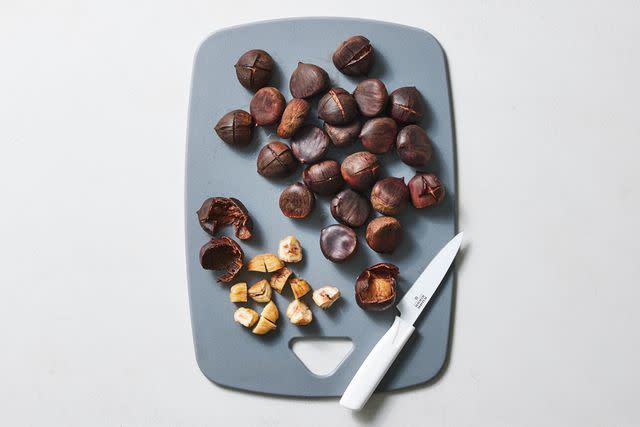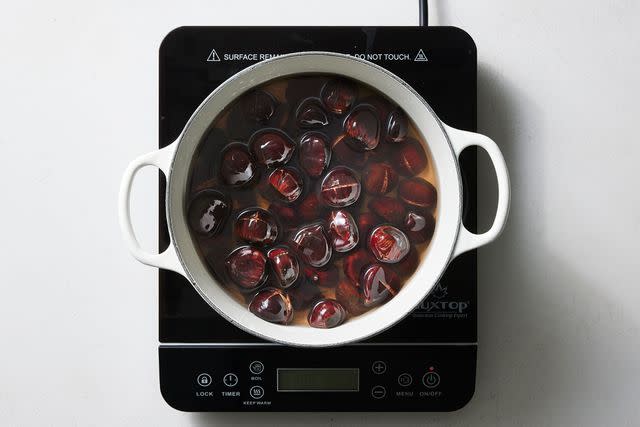The Best Way to Roast Chestnuts—Open Fire Not Required

- Oops!Something went wrong.Please try again later.
- Oops!Something went wrong.Please try again later.
Get into the holiday spirit with our easy technique for roasting chestnuts in your oven.
You've no doubt heard crooners like Nat King Cole and Bing Crosby sing about roasting chestnuts on an open fire during the holiday season, but have you embraced this tradition? Many cultures associate chestnut trees and their harvest rituals with the winter holidays, and many cuisines use chestnuts for special recipes. In the United States, the smell of roasted chestnuts is a surefire sign that the holidays are in full swing. And luckily, the open hearth is not the only way to roast them. You can experience and enjoy this tradition even in your apartment. Follow our guide to how to roast chestnuts, and you’ll have warm, buttery chestnuts for everyone to snack on or to use in some of your favorite seasonal recipes.

Rachel Marek
Related: 16 Holiday Roast Recipes for Every Delicious Occasion
Why We Roast Chestnuts
Most of us don't have an open fire to toast chestnuts safely. Nevertheless, this time-honored tradition has stuck around for a reason. Chestnuts have an unmatched flavor and a short season, so it’s best to appreciate them while you can. When roasted, they become sweet, buttery, and tender. Think about the sweetest, most flavorful roasted sweet potato you've ever eaten—it's very similar to the flavor of chestnuts. And much like sweet potatoes, chestnuts can add a unique flavor to both sweet and savory dishes.
Roasting chestnuts in your oven has a few benefits. For starters, it's simple. While they do require a bit of prep work, once they go into the oven, you can pretty much forget about them until the timer goes off. Most importantly, they're delicious. They will fill your home with a sweet, buttery aroma, and you can use them in your favorite recipes.
How to Roast Chestnuts in the Oven
What you need: A sharp paring knife, cutting board, rimmed baking sheet (or roasting pan or oven-safe skillet), and a clean kitchen towel.
Preheat the oven: A standard temperature of 350°F is great for roasting chestnuts.
Make an "X": Using the base of a sharp paring knife, make a very small (about ⅛-inch) incision through the bottom of each chestnut's shell. Cut just until you hit the flesh of the nut, and maneuver the knife all the way up the bottom half of the shell. Then do it again to make an "X." This way, when the chestnuts roast, the shells will crack open completely, and peeling will be easier.
Soak: Soak the chestnuts in a bowl of water for 30 minutes; this will help ensure they don't dry out when roasting.
Roast: Arrange the chestnuts in an even layer on a rimmed baking sheet. Roast for about 35 minutes, or just until the shells have cracked and the nuts inside are exposed.
Peel: Chestnuts are easiest to peel while they're still hot, so grab a clean kitchen towel and use it to pry open the shells. Discard each shell and any papery skins that are attached to the nuts.
Tips
Chestnuts can be a tough nut to crack, but when they are cooked properly, the shells slip off pretty easily. The trick is to make sure the inner nut is thoroughly cooked and tender before peeling. And of course, make sure to peel the nuts while they're still hot from the oven.
Alternative Cooking Methods
Roasting chestnuts really brings out all of their deep, earthy flavor, but there are a few other ways to prepare them. If you're looking to use chestnuts more for their texture than flavor, consider boiling or steaming them.

Rachel Marek
Boiling
Prepare the chestnuts the same way you would if roasting by carving the "X" into each shell. Then drop them into a big pot of boiling water and cook until the shells begin to split and the meaty insides are tender, 15 to 20 minutes.
Steaming
Again, follow the same preparation steps, then pile the chestnuts into a large pot fitted with a steamer basket and filled with a few inches of water. Cover the pot and let the nuts steam over medium-low heat until cooked, around 20 minutes.
Serving and Enjoying Roasted Chestnuts
As well as eating chestnuts warm from the oven (perhaps sprinkled with a touch of salt), you can chop them up and use them in all kinds of holiday recipes.
Savory
Chestnut stuffing is a popular addition to any festive meal, whether served on its own or inside a roast. Chestnuts are also delicious when cooked with hearty vegetables like fennel or Brussels sprouts. Use them to add meatiness to creamed greens or even the fan-favorite green bean casserole. Or bulk up creamy mushroom or pumpkin soups with chestnuts—their nutty flavor and chewy texture is great blended in or sprinkled on top.
Sweet
Chestnuts also add a wonderful flavor to many desserts. Their texture is perfect for a creamy sandwich cookie or layer cake filling. Like any other nut, they can be pulsed into a fine powder to make chestnut flour, which can be used much like almond flour when baking. We like to use it to make pancakes, crepes, and meringues.
Read the original article on Martha Stewart.

